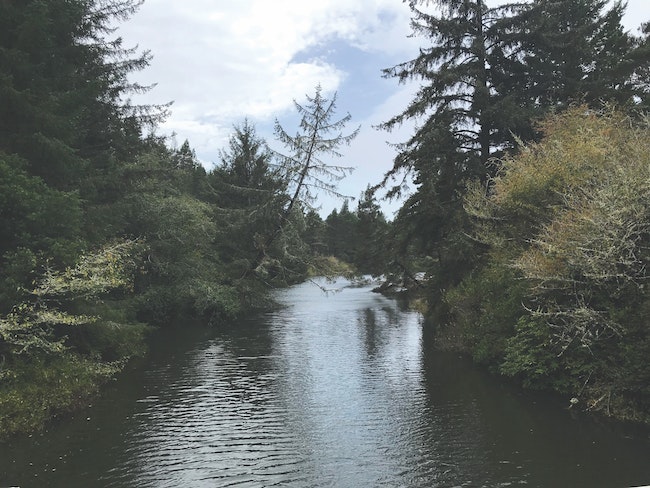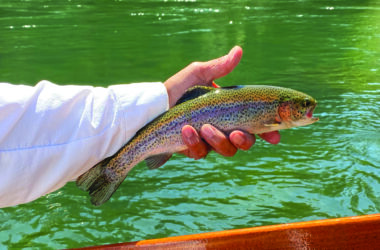 Siltcoos River was flooded by high tides and a storm surge several days last week that washed out the sandbar at the beach, allowing coho salmon to stream into Siltcoos, Tahenitch and Tenmile lakes on the central coast. PHOTO BY FRANK ARMENDARIZ
Siltcoos River was flooded by high tides and a storm surge several days last week that washed out the sandbar at the beach, allowing coho salmon to stream into Siltcoos, Tahenitch and Tenmile lakes on the central coast. PHOTO BY FRANK ARMENDARIZ
After a long, hot and dry summer, in what was a historic year of drought that extended into the early fall across all of Oregon and most of the western United States … It has finally rained. But the damage is done and making matters worse, our historic drought came after several years of below-average precipitation that has left us with quite a deficit to overcome. And it will take several years of normal rain and snowfall accumulations to fully recover. But a cool and wet weather pattern has settled in across the Pacific Northwest. With any luck, the welcoming wet weather will be with us into the weekend and hopefully far beyond.
In years with normal amounts of precipitation we would usually see the “drawdown” of all the valley reservoirs this time of year. But most of the Willamette Valley reservoirs are already nearly empty. The resulting rise in water levels on the Willamette and McKenzie rivers would generally put the fish down for the season, but this season is an exception and trout fishing on the McKenzie and on the Willamette up to Harrisburg has remained good this fall. Also worth the effort, a few late-run summer steelhead have found their way to the base of Leaburg Dam and have provided an exciting bi-catch opportunity this fall too. The McKenzie is open year-round for trout and steelhead fishing and through the winter months is a good bet whenever the river drops below 2.5 feet on the Vida river gauge. It’s always catch-and-release for the wild trout but there are generally plenty of hatchery trout left over in fall. Particularly from Finn Rock downstream to Hendricks Wayside but after Nov. 1 you are now restricted to flies and lures only until next May.
The change in the weather and the accompanying rainfall has sweetened many urban water bodies as well and the ODFW recently planted hatchery trout in a number of the Willamette valleys, ponds and lakes. It will likely be the final plant until late December when the hatchery program ramps up again in earnest. Locally, Alton Baker Channel was planted in the last week of October with some very nice oversized brood trout and will get 1,300 more rainbow trout on Nov. 5. As will Junction City Pond, which is scheduled to get 1,300 rainbows the first week in November too, and more trout will be added to JC pond in time for Thanksgiving and Christmas.
Over on the coast, from about the Coos Bay north, the rainy weather has pretty much ended the bay salmon fishery and most fall salmon are now on the spawning beds far upriver. On the Siuslaw a handful of boats were still working the upper estuary at Mapleton last weekend but the numbers of anglers were way down as compared to just a week ago. I have seen some very nice chinook caught in the lower river, below the confluence of Lake Creek but time is running out on that part of the river too.
Salmon fishing isn’t entirely over for the year, our south coast fisheries are actually just coming into season and generally don’t peak until late November. The best so far has been the Chetco River on the far south Oregon coast, as recent storms ushered in an “atmospheric river” over southern Oregon and northern California and dropped close to a foot of rain on some locations. After a brief blow out, the Chetco has receded and was bumping along at a perfect 2,500cfs (cubic feet per second) this week. With more rain in the forecast the Chetco and other south coast rivers will continue to be solid prospects. River levels on the Elk and Sixes have been low but are poised to rise to fishable levels with a little more rainfall too and are generally prime around Thanksgiving week. A daily report from the Elk River hatchery can be found by calling 541-332-0405. The information is updated at about 8:30 each morning during the salmon season. On the Elk River it’s hatchery salmon only, while on all the other south coast rivers there are a variety of individual management plans in place. So always check the regulations on the specific south coast stream you plan to fish. Pistol River, Hunter Creek and Flores Creek are always worth a look on the south coast.
Along with the atmospheric river came a coastal storm surge that pushed bay water far up every estuary all along the entire Oregon Coast. On the Siltcoos River, Tahkenitch Creek and Ten Mile Creek the high tide flooded over the beach where the streams meet the ocean, opening the sandbars and allowing silver salmon to begin their annual migration into the dune lake that shares the stream’s name. They eventually work their way into the small creeks that flow from the coast mountain range and feed each of these expansive coastal lakes to spawn. Most anglers will target the creek arms of each lake, trolling 3-60 spinners behind triangle flashers or set up in locations where they can cast spinners near the head of the lake arms. Silver salmon or “coho“ were plentiful this last season and it allowed for some liberal limits on wild coho. That abundance will also be reflected in the lake fishery that generally peaks in late November and holds up well into December. In aggregate you are able to keep five wild coho salmon from the dune lakes per season in total.
One final heads-up; the first “king tides” of the season will hit the Oregon coast starting on Nov. 5, lasting until the 8th when the tidal exchange will flatten into the following week. Although king tides can present a variety of beach and jetty hazards, I suspect that the extreme high tides will be a positive development for late-season salmon fisheries.
Email: [email protected]
Listen: KDUN on 1030AM








